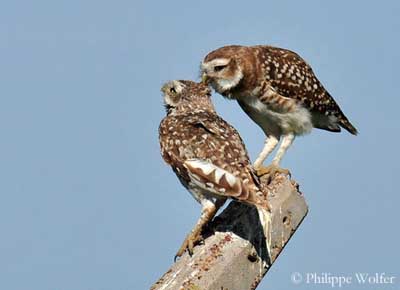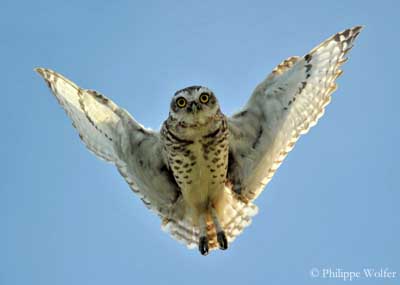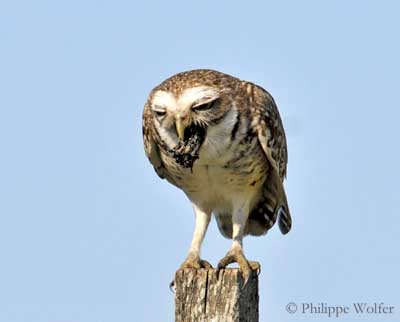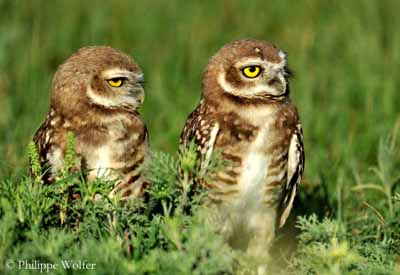Text by Nicole Bouglouan
From an observation by Philippe and Aline Wolfer, authors of the pictures displayed on this page.
Photographs by Philippe and Aline Wolfer
OISEAUX D’ARGENTINE
For more information about the Burrowing Owl: click HERE
Sources:
HANDBOOK OF THE BIRDS OF THE WORLD Vol 5 by Josep del Hoyo-Andrew Elliott-Jordi Sargatal - Lynx Edicions - ISBN: 8487334253
Animal Diversity Web (University of Michigan Museum of Zoology)
Wikipedia (Wikipedia, The Free Encyclopedia)
What Bird-The ultimate Bird Guide (Mitchell Waite)
Burrowing Owl’s breeding behaviour
Athene cunicularia
The Burrowing Owl is the only one within the Strigidae Family in using burrows for nesting.
These owls do not excavate the burrows, but they use abandoned holes dug by prairie-dogs, ground squirrels, skunks, marmots or other mammals. They only arrange the nest-site, enlarging it if necessary and cleaning it. They dig and kick backwards with the feet, but they also can dig with the bill.
However, in soft sandy soil, they are quite able to dig the burrow themselves, how they do in Florida or in the West Indies.
The breeding season occurs between March and August. The Burrowing Owl is usually monogamous, with some records of polygamy, and the pair-bonds’ duration may vary among the different races.
The burrow can be isolated or near other burrows, according to the area. They are often situated close to a road and surrounded by bare ground, or in grazed pastures at higher level. They collect horse and cow manure to line the floor of the burrow. Several studies suggest that the odour of the dung may mask that of owls, and protect them from detection by ground predators.
They have several burrows around the most important, used by males during the nesting period and by the juveniles after they go out from the first nest.
According to the range, they can nest in residential areas as they do in Florida where they dig the burrow in elevated areas, probably to avoid flooding.
The Burrowing Owl’s breeding success depends on food resources and predation of eggs and young, but also on weather conditions.
During the day, this owl is often seen keeping watch from an exposed site (often a termite mound), looking for predators and intruders.
They are mostly nocturnal, but they also are active by day, and mainly at twilight.
The Burrowing Owl, as several Strigidae species, performs mutual preening. This behaviour is practised by both mates, but can also occur between adult and young, or among juveniles of the same brood.
Very common, this ritualized behaviour is shared in peaceful and non-aggressive way, often on head and face of the other bird, and may play a role in feather care and during courtship.

Some displays are observed, with the male calling, performing circular flights and other aerial displays such as rising quickly, hovering for a few seconds, and dropping from about 15 metres. It repeats this scene many times.

They also practise mutual preening and billing between mates, bowing and scratching too, and the male presents food to the female. These displays are accompanied by calls.
The female lays 6-11 white eggs and incubate alone during about one month, while the male hunts and feeds her. At hatching, the precocial chicks are partially covered in down. They fledge about 44 days later, and remain in the vicinity of the burrow. They can be seen testing their wings by stretching and beating them around the nest-entrance. They often stand together, very quiet, waiting for the adults and the food.
At dusk, they often follow their parents during their foraging trips. The female hunts again when the young are less dependent.
They hunt by walking, hopping and running on the ground, but also by flying from a perch, hovering over the vegetation and even flycatching in the air.
They reject pellets including the indigestible parts of the preys.

They catch the prey with one foot and transfer it to the bill for carrying it to the nest and feed the young.
Little by little, the young owls leave the nest-site and become independent. They will be sexually mature at one year.

The Burrowing Owl is a very pretty bird. This observation was recently done by the authors of all these pictures, in Northern Argentina.
They spent numerous hours in the relatively close vicinity of the burrow but without disturbances, and the owls which first, were fairly wary towards the visitors, became much more co-operative the following days.
Enjoy these beautiful pictures of a happy family!